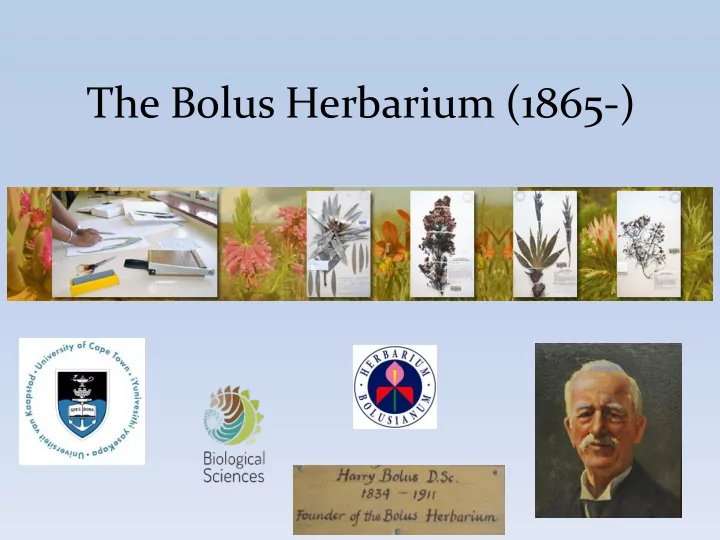

The Bolus Herbarium (1865-)
Oldest functioning and currently 3 rd largest herbarium in South Africa, 5 th largest in Africa. Established 1865 = 152 years old this year Bolus’s first homestead in Cape Town, where the herbarium was once housed Library Bolus Herbarium and Library had humble beginnings: consisted of rooms in a private home before being bequeathed to UCT in 1911 Herbarium
Herbarium and associated library moved 10 times: now housed in modern facilities in the Dept. of Biological Sciences
± 90% of collections are from Cape Floral Kingdom (CFR) = regional herbarium Proteaceae 333 spp., 96% endemic Ericaceae 680 spp., 97% Restionaceae 342 spp.,92%
Currently houses more than 380 000 collections - over 11 300 Types. These 16 taxa very well represented Aizoaceae ( Mesembryanthemaceae ) Asclepiadaceae Asteraceae Bryophyta & Hepatophyta Cyperaceae Ericaceae Fabaceae Geraniaceae Iridaceae Orchidaceae Oxalidaceae Poaceae Proteaceae Pterydophyta Rutaceae Scrophulariaceae One of the herbarium’s oldest collections is of Agathosma ovata made on 11/07/1814
Staff, students, visitor conducting research ↑ ↗ STATS: Average 2014-2016 New acquisition ↓ Visitor usage : 358 p/a 60% UCT staff and students, 40% visitors from outside UCT Sheets handled: 7900 p/a (loans in and out, gifts in and out, new specimens accessioned) Material loaned from other ↑ herbaria for research purpose s
STAFF 1. Curator: PSO/Curator 2. Curator: Succulent Families 3. Herbarium Assistant Staff shortage our most pressing concern 2001 - 2017 1986 A number of important aspects of effective Herbarium management are affected and compromised, particularly: • Curatorial duties – both physical sheets and the metadata require curation. • Pressure on loan management system. • Administration.
1400000 Accessioned specimens / samples-Value Specimen to scientific staff ratio 1200000 1000000 800000 Are these herbaria at high risk due to limited staff capacity? 600000 400000 200000 0 National Compton Bolus Selmar Bews KZN Herbarium, Herbarium Herbarium Schonland Herbarium Herbarium Pretoria Herbarium *Data obtained from national collections review undertaken by NRF in 2010
DIGITIZATION Current Situation: Own system started 1993 – as a loan management system - continually developed/upgraded to meet most current needs - effective - now migrated to BRAHMS system. Ad hoc data capturing (encoding): specimen loans, systematists providing funds, student projects, specific projects - Mellon Foundation (all Type collections scanned + metadata for API), OBIS (Ocean Biodiversity Information System) project (all marine algae databased), FBIP. Databased to date: Non-types: 173 800 Types: 11 300 TOTAL: ± 185 000 (± 50% of collections) Geo-referenced: 50 000 (27% of databased records) Images of 3 500 scanned Mesemb “ Vygie ” illustrations - housed by UCT Libraries’ Digital Repository Unit Karoo BioGaps Project, targeting 6 major families, when done, over 200 000 records will be captured and 80 000 geo-referenced.
MOST PRESSING PROBLEMS All funds to ensure both data capturing and specimen mounting (fundamental functions) continually need to be externally sourced – almost all funds are dedicated to paying salaries of ad hoc personn el. Succession - no “in - house” training for future leadership – a Herbarium Curator requires at least 5 years of shadow-training should successful transition be required. Each herbarium, particularly non-SANBI herbaria, has its own unique set of conditions under which it operates. Problem of expansion – expensive, yet required for collections to constantly grow and for collection to consistently be of increasing value to science. Though three University Herbaria list amongst the top six in the country in terms of number of specimens housed, they are probably most at threat due to being under-resourced w.r.t. human capital. Dedicated staff members have kept these in the loop regarding scientific relevance. Could be problem in future.
FUTURE • Investigating the possibility of expansion within the next three years – increase potential to continue accessioning new material. • To digitise the entire collection as soon as possible – result - having all the data at hand as well as an image of each specimen. • Have all these data in a centralised repository for use by all who might require the information. NSCF to play a pivotal role. • Recruit volunteers, interns, temporary staff to try and alleviate staffing shortfall.
Take home message: Herbaria play a critical role - preserve the results of diligent fieldwork for future generations, and are an essential part of the biodiversity infrastructure of any country
ACKNOWLEDGEMENTS Organisations and individuals SANBI, particularly Prof. Michelle Hamer for ensuring the establishment of the NSCF has been brought to fruition Certain Slides: Peter Linder:
Recommend
More recommend